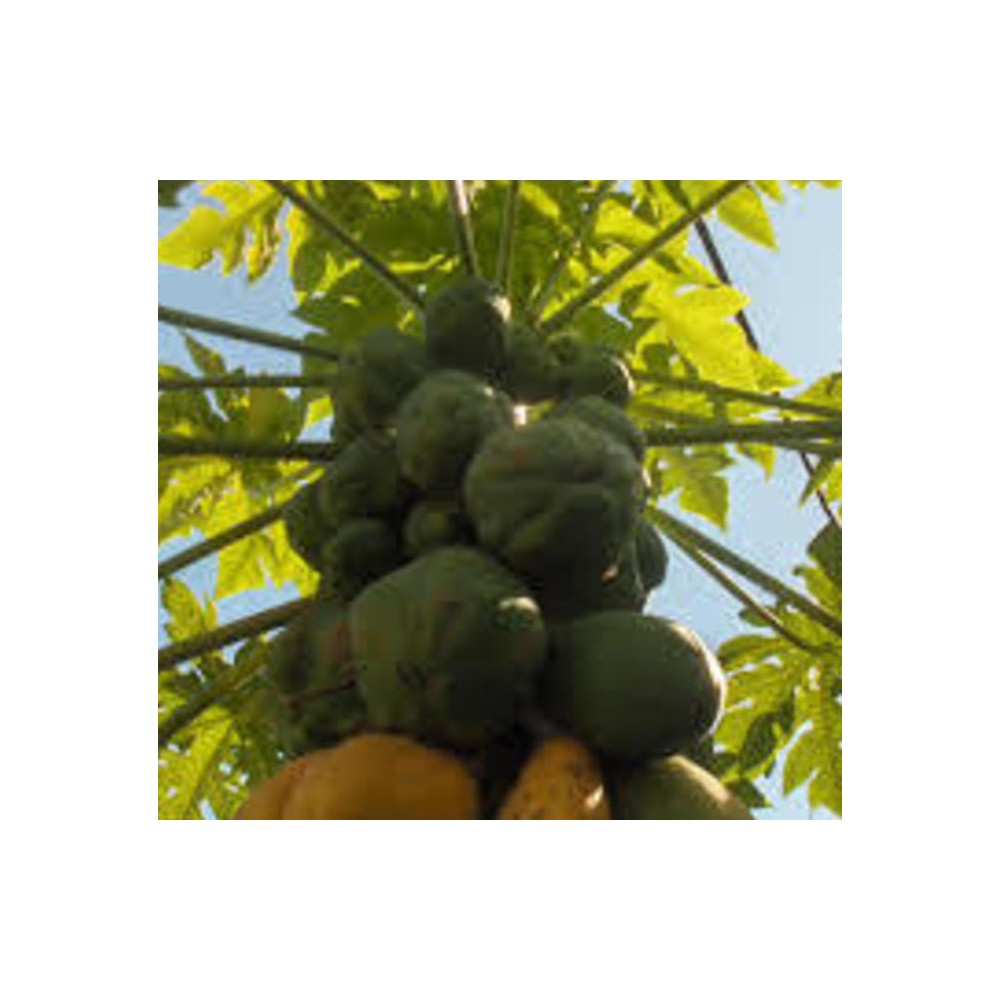



Papayas (Carica papaya) grow in U.S. Department of Agriculture plant hardiness zones 10 through 11. However, they can also be planted in USDA zones 8 through 10 in large pots that can be brought indoors so that cold weather doesn't kill them. Although papayas look like trees, they are actually perennial herbs with hollow trunks. These branchless plants grow to 20 to 30 feet tall with 1-foot-long to 3 1/2-foot-long leaves growing directly from the trunk. Papayas are relatively fragile plants, with several common diseases, fungi and insects that can injure or kill them. Papayas require careful inspection and care of these conditions.

Security policy visit http://nurserynature.com/content/10-security-policy

Shipping & Delivery Policy visit http://nurserynature.com/content/1-delivery

Cancellation & Refund Policy visit http://nurserynature.com/content/6-aeu-legal-revocation-terms
Papayas (Carica papaya) grow in U.S. Department of Agriculture plant hardiness zones 10 through 11. However, they can also be planted in USDA zones 8 through 10 in large pots that can be brought indoors so that cold weather doesn't kill them. Although papayas look like trees, they are actually perennial herbs with hollow trunks. These branchless plants grow to 20 to 30 feet tall with 1-foot-long to 3 1/2-foot-long leaves growing directly from the trunk. Papayas are relatively fragile plants, with several common diseases, fungi and insects that can injure or kill them. Papayas require careful inspection and care of these conditions.
Papayas Planting & Care
Fill a half wine barrel or other large container with a well-draining potting mix, such as a blend of equal parts sphagnum peat, compost and coarse sand. Fill the container to about 3 inches from the top of the container. Choose containers with a capacity of at least 10 gallons to ensure enough room for papayas to thrive. The container must have drainage holes in the bottom so that excess moisture in the soil can escape. You can drill holes in the bottom, using a power drill and a 1/2-inch diameter drill bit.
Gather seeds from a mature papaya fruit to start the papaya tree. Press the seeds against a colander to break the gelatinous sarcotesta sac, and rinse the seeds thoroughly. Steep the seeds in boiling hot water for 10 to 20 seconds, then soak them overnight in room-temperature water. While this step is not required, it helps speed up the germination time so that the tree grows faster. If you want to save the seeds for later planting, rinse the seeds and lay them on a paper towel to dry; store dried seeds in a plastic bag in the refrigerator. Steep the dried seeds in hot water one day before sowing them.
Sow about 12 seeds spaced evenly in a 12-inch circle at the center of the container. Cover the seeds with 1/2 inch of soil. Water the seeds at planting, and fertilize with a complete fertilizer, such as 10-10-10, added to the water supply. Germination should occur within two weeks. Multiple seeds are needed in each planting circle to ensure that some of the resulting trees are female or hermaphroditic. Female plants bear fruit, but at least one male plant is needed for cross-pollination. Hermaphroditic trees have both male and female reproductive organs. The seeds might produce plants with female flowers or hermaphroditic flowers, so multiple plants are needed for you to determine their genders when they flower.
Thin out the seedlings about six weeks after planting, leaving the six healthiest plants in each container. Look for plants with strong growth and thick stems. Cut off plants with weak, spindly growth at soil level to avoid disturbing the roots of the remaining plants. Reduce the number of plants per container to three plants after another six weeks of growth. Let the plants grow undisturbed until flower buds develop on the plant.
Determine the genders of the young flowering plants. Female flower buds are cone-shaped, with a wide base that tapers to a point at the tip of the bud. Hermaphroditic flower buds are cylindrical with a base and tip of roughly the same size. Male flower buds are spoon-shaped, with a narrow base and wide tip. Remove all but one of the male plants from the group of new plants; leave at least one female or hermaphroditic plant. Cut the unwanted plants back to the soil.
Water the papaya plants around the root zone as needed. Papayas need plenty of water to grow tasty fruit, but the plants do not tolerate wet feet. To avoid overwatering the papaya, water deeply only when the top 1 inch of soil dries.
Apply a complete fertilizer every two months after planting, using a formula that contains nitrogen, phosphorus and potassium, such as 10-10-10.
Spray the trees regularly with fungicidal spray applied to the leaves and trunk to prevent fungal problems. Apply the fungicide once every two to three weeks if your area receives heavy rainfall; spray every three to four weeks in drier areas. Add wettable sulfur to the fungicidal spray to treat powdery mildew. Prevention is key with papaya plants, because diseases are difficult to impossible to treat once established.
Place paper bags over developing fruit, and tie them in place until harvest to prevent papaya fruit flies from infesting the fruit. These flies lay their eggs under the peel, and the larvae eat the fruit from the inside out. Remove papaya webworms with your hands, or spray them off, using a garden hose with a sprayer nozzle set to spray at high pressure. Prune damaged leaves infested with papaya whitefly; alternatively, you can spray the leaves with insecticidal soap.
Cut down your papaya tree every 18 to 24 months and start with new plants as a control measure against the buildup of common diseases, such as papaya ringspot virus, anthracnose and papaya apical necrosis. Dispose of the potting soil; do not add this to your compost pile, because any soil problems will be transferred to the compost. Wash and disinfect the container thoroughly with diluted bleach, using one part bleach to nine parts